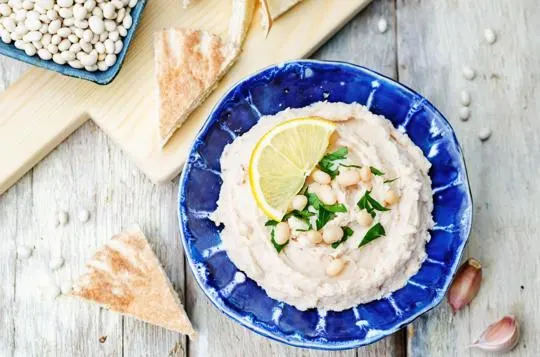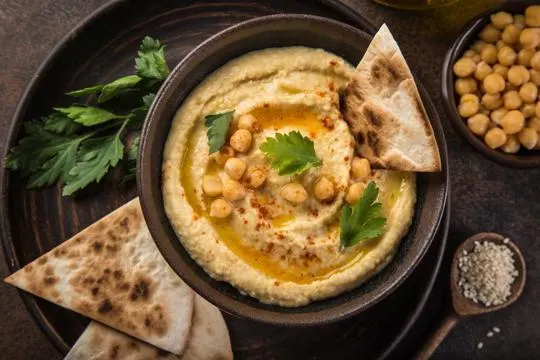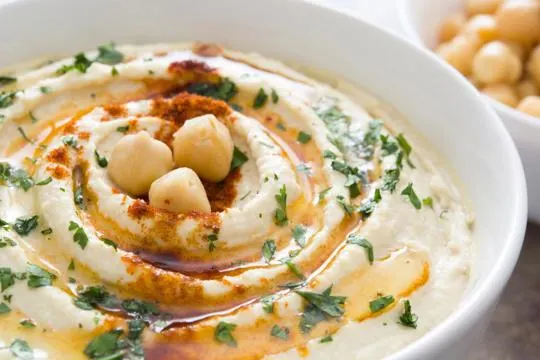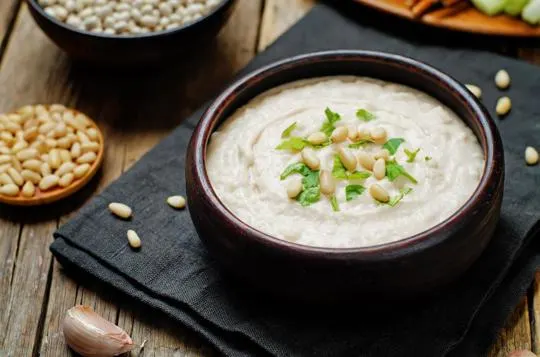Summary of key points
The main difference between white bean hummus and chickpea hummus is in the type of legume used. As the name suggests, white bean hummus is made with white beans while chickpea hummus uses chickpeas.
In terms of flavor, white bean hummus tends to have a milder taste compared to chickpea hummus. This can be attributed to the different types of beans used, with chickpeas having a stronger and nuttier flavor.
In terms of texture, both hummus varieties can be smooth and creamy, but white bean hummus may have a slightly thicker consistency due to the smaller size of white beans compared to chickpeas.
Additionally, chickpea hummus is often made with tahini (sesame seed paste) while white bean hummus may use ingredients like yogurt or avocado for added creaminess.
Beans, beans, the musical fruit.
Right? Well, in the world of hummus, they’re the stars of the show.
Chickpeas have long reigned supreme in this dip domain, yet white beans have silently crept onto the scene.
We’ve dabbled in both, getting our hands dirty (and our pita bread ready).
You might say we’re experts. The differences? Oh, they’re there.
Texture, taste, even the vibe — white bean hummus brings a creaminess that chickpea can only dream of.
Yet, chickpeas punch back with a richness that’s hard to beat.
We’re here to lay it all out. No holds barred. Grab a spoon, we’re going in.
What is White Bean Hummus?

White Bean Hummus is a unique twist on the classic Chickpea version.
It has a creamy texture and a mild flavor.
Here are 6 points to know:
- Creamy Texture – White beans have a softer texture than chickpeas, resulting in a smoother dip.
- Mild Flavor – It has a delicate taste that goes well with herbs and spices.
- Versatile – An excellent base for different flavors, such as roasted garlic or sun-dried tomato.
- Nutritional Benefits – Packed with fiber, protein, and vitamins.
- Allergy-Friendly – For those with chickpea sensitivities.
- Culinary Inspiration – Can be used in sandwiches, wraps, salads, and more.
Plus, olive oil and tahini are consistent between the two versions.
What is Chickpea Hummus?

Chickpea hummus is a Middle Eastern dip that’s popular and versatile.
It’s made from cooked chickpeas, tahini, olive oil, lemon juice, garlic, and salt.
It’s creamy and flavorful – enjoy it on dishes or use it as a dip for veggies or pita bread.
Chickpeas give hummus its special flavor.
These legumes are high in protein, fiber, iron, and folate.
They have a nutty taste and a grainy texture after blending.
Hummus is also great for your health.
It’s packed with plant-based protein, great for vegetarians and vegans.
Plus, it has lots of fiber to help digestion, keep you full, and maintain blood sugar levels.
The olive oil adds heart-healthy fats and the tahini has minerals like calcium.
If you want to customize it, add ingredients like roasted red peppers, sun-dried tomatoes, or herbs like cilantro or parsley.
You can create endless variations to suit any taste.
Differences Between White Bean Hummus and Chickpea Hummus

White bean hummus and chickpea hummus have their own unique qualities.
Both use tahini as a base.
So, no matter what your preference, these two types of hummus can satisfy any palate.
Bean Variety Used
White Bean Hummus and Chickpea Hummus may seem similar, but they differ in the type of beans used.
Chickpeas are the star ingredient in traditional hummus, while white beans bring a twist.
Chickpeas have a nutty flavor and slightly grainy texture.
They are high in protein and have an earthy taste, making them perfect for creamy, thick hummus – great for dipping or spreading.
White beans offer a milder flavor and smoother texture.
They have a creamy consistency that works well for a velvety hummus.
This type of hummus tends to be lighter in taste, which is ideal for those who like a subtle flavor.
Both hummus share similar ingredients, such as tahini, garlic, lemon juice, and olive oil.
However, the bean variety affects overall taste and texture.
Chickpea hummus has a robustness which goes well with bold flavors, while white bean hummus allows for more versatility when experimenting with flavors such as herbs or roasted veggies.
Flavor and Texture
White bean hummus and chickpea hummus offer distinct differences.
White bean hummus tastes milder and creamier, while chickpea hummus has a nutty and earthy flavor.
The texture of white bean hummus is smoother, whereas chickpea hummus has a slightly grainy consistency.
White bean hummus has a subtle sweetness that goes well with many flavors and ingredients.
It is often used as a base for herbs, spices, or roasted vegetables.
Chickpea hummus, however, has a more robust taste that stands out when combined with intense flavors such as garlic or lemon.
White bean hummus has a texture that is perfect for spreading on crackers or bread.
It is also great for dipping raw vegetables or pita chips.
Chickpea hummus, on the other hand, adds a crunch when paired with crispy toppings or used as a spread in sandwiches.
In conclusion, both white bean hummus and chickpea hummus provide unique flavors and textures.
They are both delicious and nutritious, and cater to different preferences.
Nutritional Content
Comparing white bean and chickpea hummus? Analyze their nutrition.
Both have protein and fiber.
White bean hummus is smooth and creamy.
From cannellini beans, it has iron and potassium.
Plus, vitamins C and K.
Also, fiber to aid digestion and control blood sugar.
Chickpea hummus is made from garbanzo beans.
These are packed with protein.
Also, they offer magnesium and zinc.
Plus, folate, which is vital for pregnant women.
Chickpea hummus is great for boosting protein intake.
Regional Variations
White bean hummus and chickpea hummus have regional variations.
These Mediterranean dips have unique methods of preparation and flavoring in different parts of the world.
The Middle East has a distinct chickpea hummus.
It’s made with tahini, olive oil, lemon juice, and garlic.
This gives it a creamy texture and a nutty flavor.
In Italy, white bean hummus has its own twist.
Cannellini beans, rosemary, Parmesan cheese, and extra virgin olive oil give it an earthy, creamy taste.
It’s great with Italian dishes.
Greece has a unique white bean hummus called “fava”.
It’s made with yellow split peas instead of white beans.
It’s seasoned with bay leaf and cumin for a delicious, aromatic flavor.
Fava is a popular side dish or appetizer.
Similarities Between White Bean Hummus and Chickpea Hummus

White bean hummus and chickpea hummus have much in common.
Both have a creamy texture and delightful flavor.
Made by blending the legumes with garlic, lemon juice, olive oil, and tahini, they make a nutritious snack or appetizer.
They are both versatile, as you can customize them with herbs and spices to your liking.
Whether you want a hint of cumin or sprinkle of paprika, you can get creative in the kitchen.
Nutritionally, they are on the same page.
White beans and chickpeas are abundant in plant-based protein, fiber, and essential vitamins and minerals.
They offer sustained energy and promote digestive health.
But, there are differences too.
White bean hummus has a milder flavor compared to chickpea hummus.
It is great for those who like a subtle taste or want an alternative.
And, white beans blend to a creamier texture, while chickpea hummus is grainier.
Popular Additions and Variations for Both Hummus Types
When it comes to hummus, there are lots of ways to make it amazing.
White bean hummus or chickpea hummus, you can try them all.
One popular addition is roasted garlic.
It gives a smoky flavor that works great with both types.
Herbs like parsley or cilantro make it fresh and vibrant.
For those who like spice, try red pepper flakes or paprika.
Oils like olive and sesame oil will add to the flavor.
Tahini is a must in traditional recipes.
But, if you’re feeling creative, you could switch it up with almond butter or sunflower seed butter.
Toppings like roasted red peppers, olives, feta cheese, or pine nuts are tasty choices.
Go ahead and get creative – your taste buds won’t regret it.
Conclusion
Clearly, White Bean Hummus and Chickpea Hummus are two unique options for those looking to enjoy the flavor and texture of hummus.
It all comes down to personal preference and dietary needs as both are delicious variations.
For those who appreciate a classic hummus flavor, the Chickpea version is a safe bet.
If one is looking for something a bit more daring, however, White Bean Hummus provides a fascinating option with its nutty overtone.
Either way, you can’t go wrong.
Whichever one you choose, don’t forget to accompany it with some freshly baked pita bread or crunchy vegetables for a flavor party like no other.
And why stop there? Experimentation is the key to finding out what combinations bring out the best in your individualized hummus experience.
One thing’s for sure though – there’s no going wrong with either option.

Leave a comment